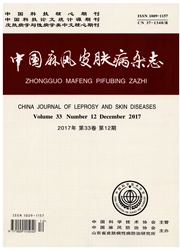

 中文摘要:
中文摘要:
目的:明确申克孢子丝菌酵母相对人急性单核细胞白血病细胞(THP-1)NF-κB信号通路激活和肿瘤坏死因子α(TNF-α)分泌的影响。方法:实时荧光定量PCR分析申克孢子丝菌酵母相刺激THP-1细胞TNF-αmRNA的表达,酶联免疫吸附法检测TNF-α分泌量,免疫印迹法分析申克孢子丝菌酵母相体外作用于THP-1细胞后IκBα和磷酸化IκBα的水平,免疫荧光法观察NF-κB-p65核转位。同时设置地塞米松(NF-κB抑制剂)抑制组,并检测100 n M地塞米松预处理THP-1细胞后TNF-αmRNA水平的变化。结果:申克孢子丝菌酵母相刺激THP-1细胞后6 hTNF-αmRNA水平显著高于空白对照组(P〈0.001)。申克孢子丝菌酵母相刺激THP-1细胞后24 h,TNF-α蛋白水平为(4610.419±121.501)pg/mL,显著高于空白对照组(186.964±98.073)pg/m L,差异具有统计学意义(P〈0.001)。申克孢子丝菌酵母相作用THP-1细胞后30~60 min,磷酸化IκBα蛋白水平显著升高,为时间依赖性。申克孢子丝菌酵母相组细胞核内NF-κB-p65较空白对照组荧光强度增强。100 nM地塞米松预处理各组THP-1细胞后,TNF-αmRNA水平较前明显降低。结论:人THP-1细胞体外与申克孢子丝菌酵母相作用后激活NF-κB信号通路并上调TNF-α分泌。
 英文摘要:
英文摘要:
Objective:To determine the effects of Sporothrix schenckii yeasts on the activation of NF -κB signal pathway and secretion of TNF-α in human acute monocytic leukemia cells ( THP-1) . Methods: The expression of TNF-αmRNA was detected by Real-time fluorescence quantitative PCR and enzyme-linked im-munosorbent assay respectively. The level of phosphorylated IκBαwas detected by Western blot. NF-κB-p65 nuclear translocation was measured by immunofluorescence. The level of TNF-α mRNA in THP-1 pretreated with 100 nM Dexamethasone ( a NF-κB inhibitor) for 30 minutes was detected by Real-time fluorescence quantitative PCR. Results: The levels of TNF-α mRNA in THP-1 cells treated with Sporothrix schenckii yeasts for 6 hours were increased compared with the blank control group (P〈0.001). The secretion level of TNF-α in the Sporothrix schenckii yeasts group was 4610.419±121.501 pg/mL, which was higher than that in the blank group (186.964±98.073 pg/mL), with a significant difference (P〈0.001). Phosphorylation IκBαprotein increased obviously and in a time-dependent manner after treated with Sporothrix schenckii yeasts from 30 minutes to 60 minutes. The fluorescent intensity of NF-κB-p65 in the Sporothrix schenckii yeasts group was stronger than that in the blank group. The level of TNF-α mRNA was decreased in the THP-1 macrophages treated with 100 nM dexamethasone in the three groups. Conclusion:Sporothrix schenckii yeasts can increase the expression of TNF-α through enhancing the activation of NF-κB pathway.
 同期刊论文项目
同期刊论文项目
 同项目期刊论文
同项目期刊论文
 期刊信息
期刊信息
